Linked Comprehension from CENGAGE PHYSICS Chapter 39 PHOTOELECTRIC EFFECT for Class 12
| Class 12 | PHYSICS |
| Chapter | PHOTOELECTRIC EFFECT |
| CENGAGE PHYSICS | Linked Comprehension |
| Medium | English |
| Academic Year | 2023-2024 |
Question 9
Photoelectrons ar ejected from a surface when light of wavelenght λ1=550nm is incident on it. The stopping potential for such electrons is λS1=0.19V. Suppose that radiation of wavelength λ2=190nm is incident of the surface. ltbRgt Q. Calculate the threshold frequency for the surface.View SolutionQuestion 10
In a photoelectric effect experiment, a metallic surface of work function 2.2 eV is illuminated with a light of wavelength 400 nm. Assume that an electron makes two collisions before being emitted and in each collision 10% additional energy is lost.
Q. Find the kinetic energy of this electron as it comes out of the metal.View SolutionQuestion 11
In a photoelectric effect experimetent, a metallic surface of work function 2.2 eV is illuminated with a light of wavelenght 400 nm. Assume that an electron makes two collisions before being emitted and in each collision 10% additional energy is lost.
Q. After how many collisions will the electron be unable to come out of the metal?View SolutionQuestion 12
In a photoelectric setup, a point source of light of power 3.2×10−3 W emits monoenergetic photons of energy 5.0 eV. The source is located at a distance of 0.8 m from the center of a stationary metallic sphere of work function 3.0 eV and of radius 8.0×10−3m. The efficiency of photoelectron emission is 1 for every 106 incident photons. Assume that the sphere is isolated and initially neutral and that photoelectrons are instantaneously swept away after emission.
Q. Calculate the number of photoelectrons emiited per second .View SolutionQuestion 13
In a photoelectric setup, a point source of light of power 3.2×10−3 W emits monoenergetic photons of energy 5.0 eV. The source is located at a distance of 0.8 m from the center of a stationary metallic sphere of work function 3.0 eV and of radius 8.0×10−3m. The efficiency of photoelectron emission is 1 for every 106 incident photons. Assume that the sphere is isolated and initially neutral and that photoelectrons are instantaneously swept away after emission.
Q. It is observed that photoelectron emission stops at a certain time t after the light source is switched on. It is due to the retarding potential developed in the metallic sphere due to lift over positive charged. The stopping potential (V) can be represented asView SolutionQuestion 14
in an experimental set up to study the photoelectric effect a point source of light of power 3.2×10−3 W was taken. The source can emit mono energetic photons of energy 5eV and is located at a distance of 0.8 m from the center of a stationary metallic sphere of work-function 3.0 eV. The radius of the sphere is r=8×10−3 m. The efficiency of photoelectric emission is one for every 106 incident photons. Based on the information given above answer the questions given below. (Assume that the sphere is isolated and photoelectrons are instantly swept away after the emission).
Time after which photoelectric emission stops isView SolutionQuestion 19
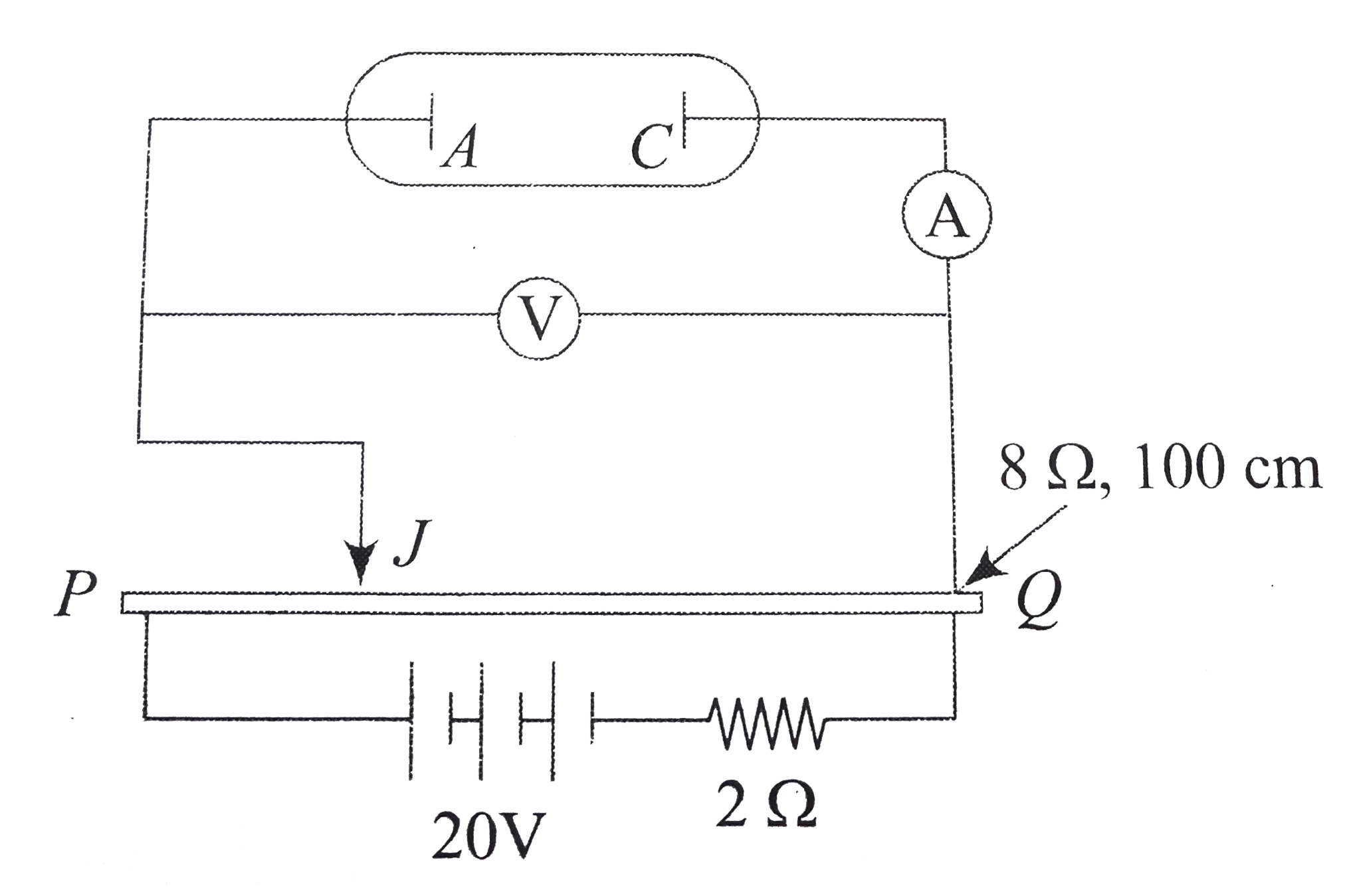
An experimental setup of verification of photoelectric effect is shown if Fig. The voltage across the electrodes is measured with the help of an ideal voltmeter, and which can be varied by moving jockey J on the potentiometer with wire. The battery used in potentiometer circuit is of 20 V and its internal resistance is 2Ω. The resistance of 100 cm long potentiometer wire is 8Ω.
The photocurrent is measured with the help of an ideal ammeter. Two plates of potassium oxide of area 50cm2 at separation 0.5mm are used in the vacuum tube. Photocurrent in the circuit is very small, so we can treat the potentiometer circuit as an independent circuit. The wavelength of various colors is as follows:
Q. Calculate the number of electrons that appear on the surface of the cathode plate, when the jockey is connected at the end P of the potentiometer wire. Assume that no radiation is falling on the plates.View SolutionQuestion 20

An experimental setup of verification of photoelectric effect is shown if Fig. The voltage across the electrodes is measured with the help of an ideal voltmeter, and which can be varied by moving jockey J on the potentiometer with wire. The battery used in potentiometer circuit is of 20 V and its internal resistance is 2Ω. The resistance of 100 cm long potentiometer wire is 8Ω.
The photocurrent is measured with the help of an ideal ammeter. Two plates of potassium oxide of area 50cm2 at separation 0.5mm are used in the vacuum tube. Photocurrent in the circuit is very small, so we can treat the potentiometer circuit as an independent circuit. The wavelength of various colors is as follows:
Q. When radiation falls on the cathode plate, a current of 2μA is recorded in the ammeter. Assuming that the vacuum tube setup sollows Ohm's law, the equivalent resistance of vacuum tube operating in this case when jockey is at end P is View SolutionQuestion 21
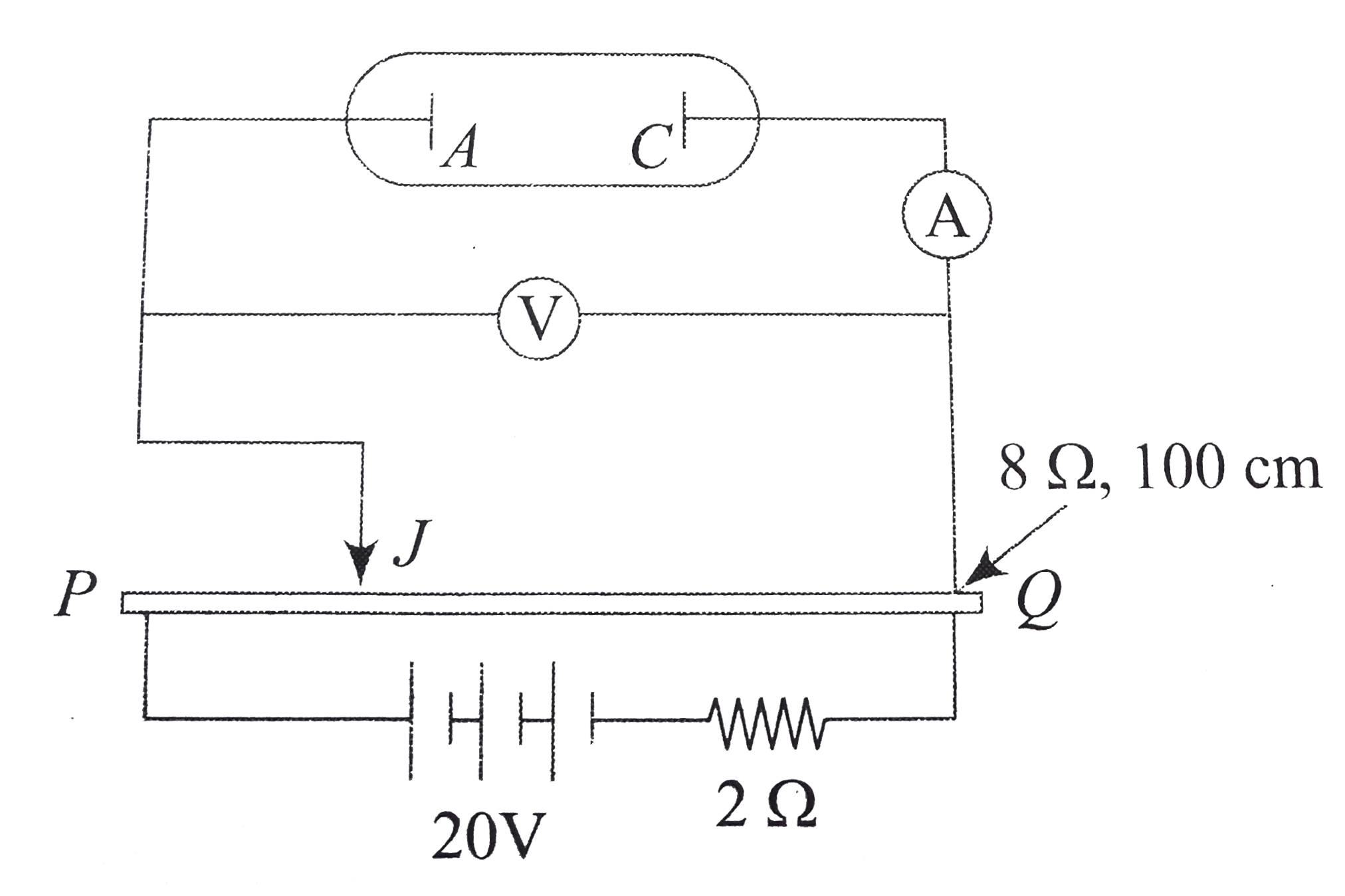
An experimental setup of verification of photoelectric effect is shown if Fig. The voltage across the electrodes is measured with the help of an ideal voltmeter, and which can be varied by moving jockey J on the potentiometer with wire. The battery used in potentiometer circuit is of 20 V and its internal resistance is 2Ω. The resistance of 100 cm long potentiometer wire is 8Ω.
The photocurrent is measured with the help of an ideal ammeter. Two plates of potassium oxide of area 50cm2 at separation 0.5mm are used in the vacuum tube. Photocurrent in the circuit is very small, so we can treat the potentiometer circuit as an independent circuit. The wavelength of various colors is as follows:
Q. It is found that ammeter current remains unchanged (2μA) even when the jockey is moved from the end P to the middle point of the potentiometer wire. Assuming that all the incident photons eject electrons and the power of the light incident is 4×10−6 W. Then, the color of the incident light is View SolutionQuestion 22
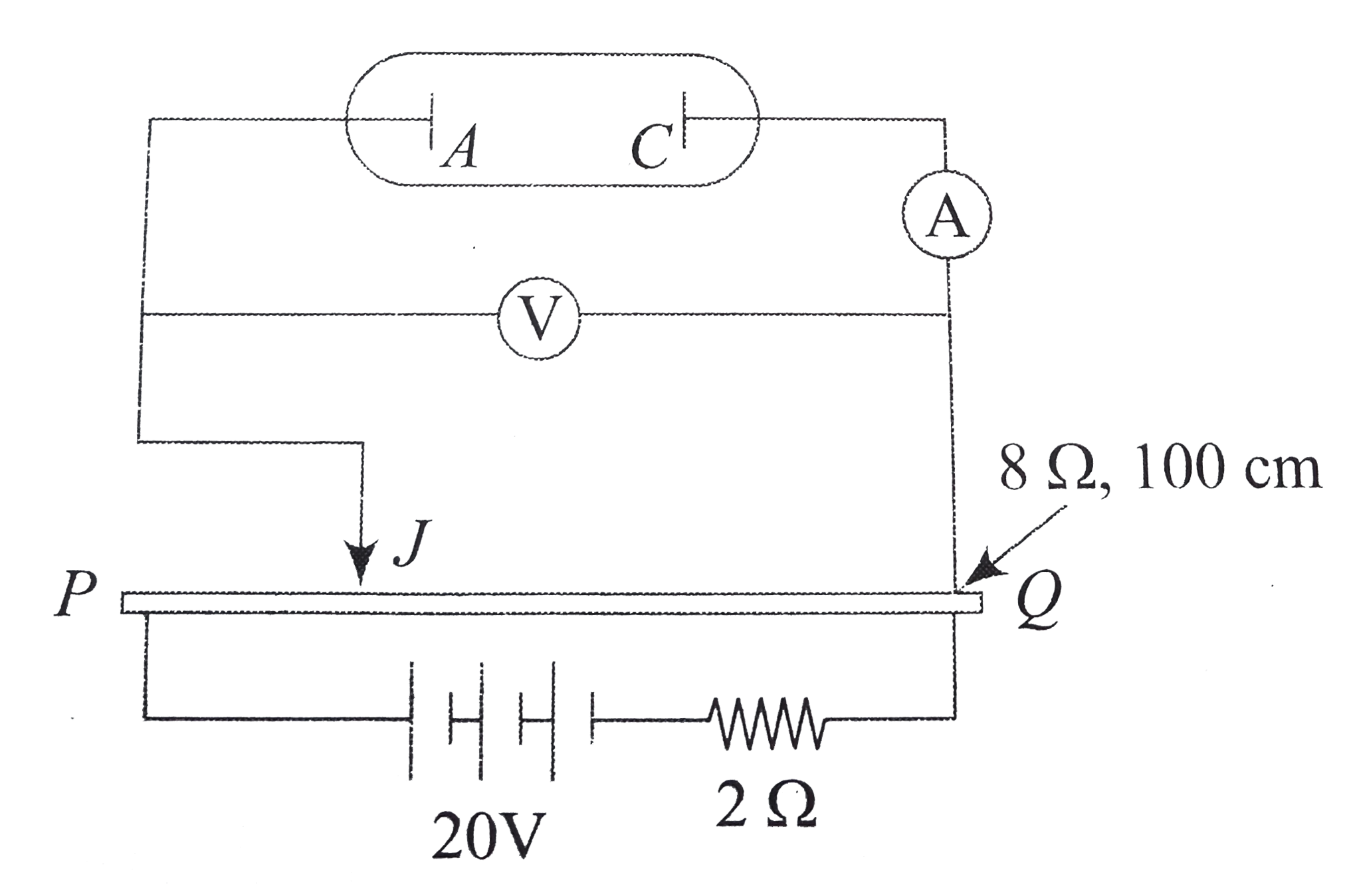
An experimental setup of verification of photoelectric effect is shown if Fig. The voltage across the electrodes is measured with the help of an ideal voltmeter, and which can be varied by moving jockey J on the potentiometer with wire. The battery used in potentiometer circuit is of 20 V and its internal resistance is 2Ω. The resistance of 100 cm long potentiometer wire is 8Ω.
The photocurrent is measured with the help of an ideal ammeter. Two plates of potassium oxide of area 50cm2 at separation 0.5mm are used in the vacuum tube. Photocurrent in the circuit is very small, so we can treat the potentiometer circuit as an independent circuit. The wavelength of various colors is as follows:
Q. Which of the following colors may not give photoelectric effect for this cathode?View SolutionQuestion 23
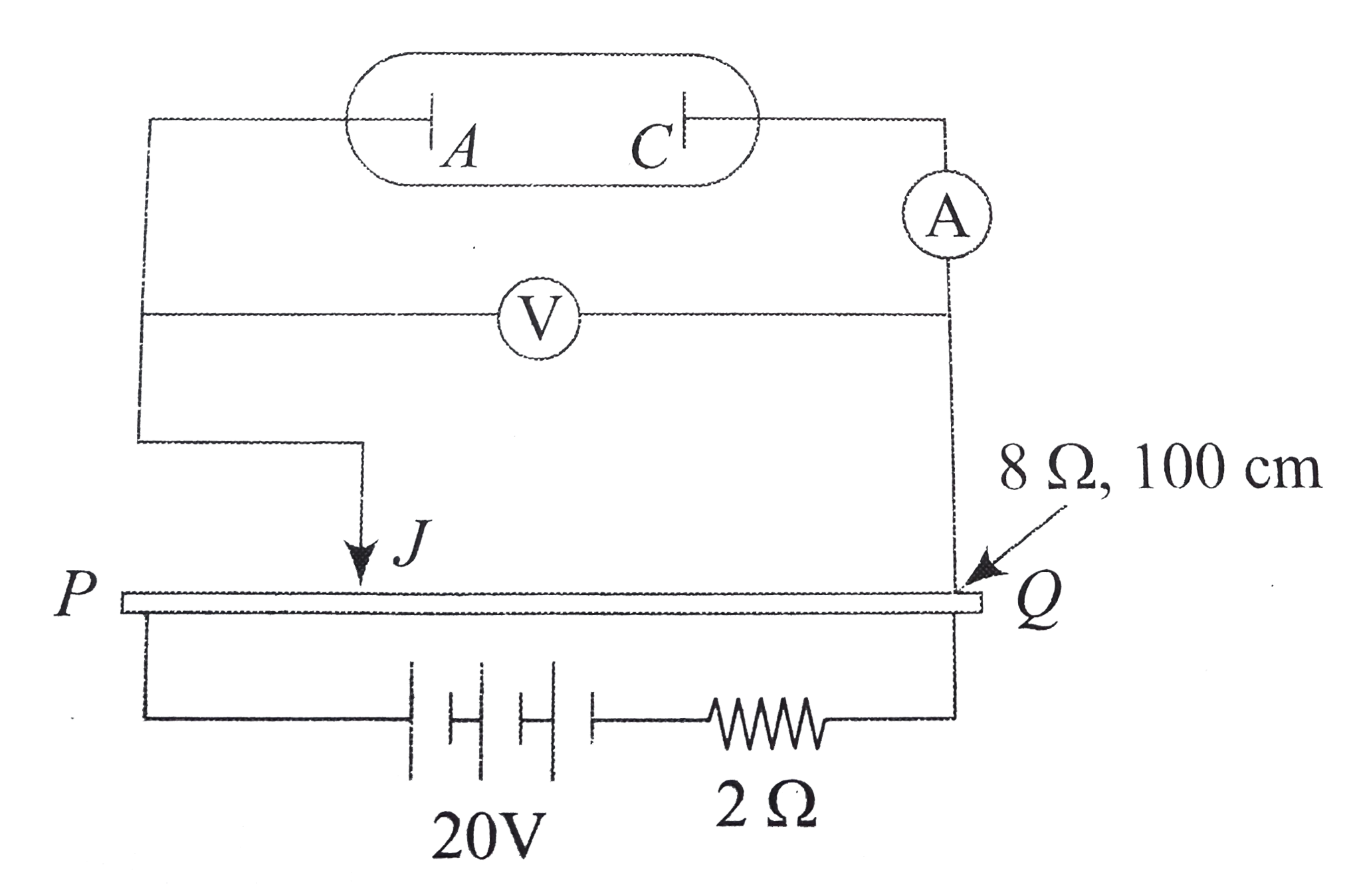
An experimental setup of verification of photoelectric effect is shown if Fig. The voltage across the electrodes is measured with the help of an ideal voltmeter, and which can be varied by moving jockey J on the potentiometer with wire. The battery used in potentiometer circuit is of 20 V and its internal resistance is 2Ω. The resistance of 100 cm long potentiometer wire is 8Ω.
The photocurrent is measured with the help of an ideal ammeter. Two plates of potassium oxide of area 50cm2 at separation 0.5mm are used in the vacuum tube. Photocurrent in the circuit is very small, so we can treat the potentiometer circuit as an independent circuit. The wavelength of various colors is as follows:
Q. When other light falls on the anode plate, the ammeter reading remains zero till jockey is moved from the end P to the middle point of the wire PQ. Thereafter, the deflection is recorded in the ammeter. The maximum kinetic energy of the emitted electron is View SolutionQuestion 24
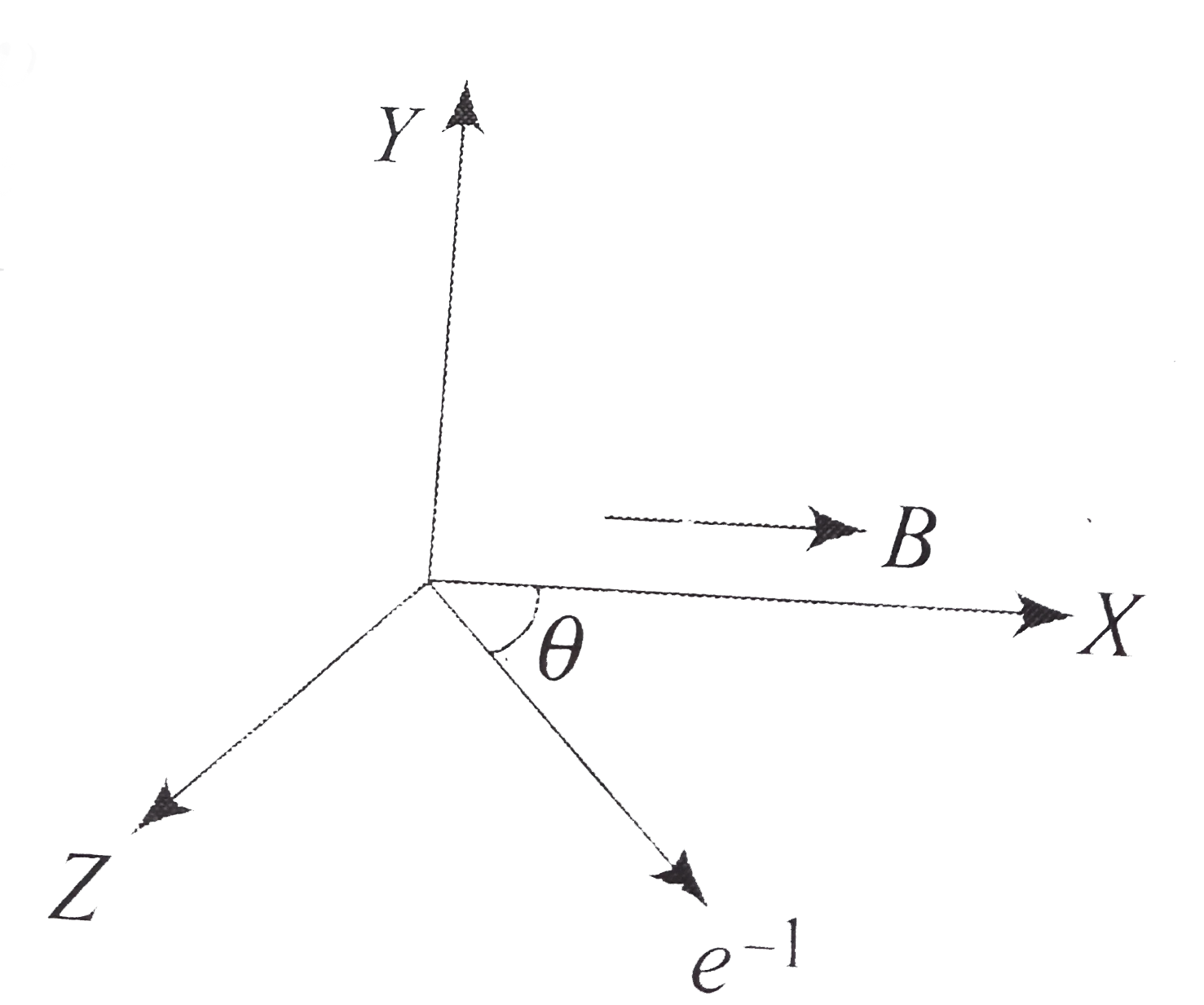
Light having photon energy hυ is incident on a metallic plate having work function ϕ to eject the electrons. The most energetic enectrons are then allowed to enter in a region of uniform magnetic field B as shown in Fig. The electrons are projected In X-Z plane making an angle θ with X-axis and magnetic field is →B=B0ˆi along X-axis maximum pitch of the helix described by an electron is found to be p. Take mass of electron as m and charge as q. Based on the above information, answer the following questions:
Q. The correct relation between p and B0 is View SolutionQuestion 25
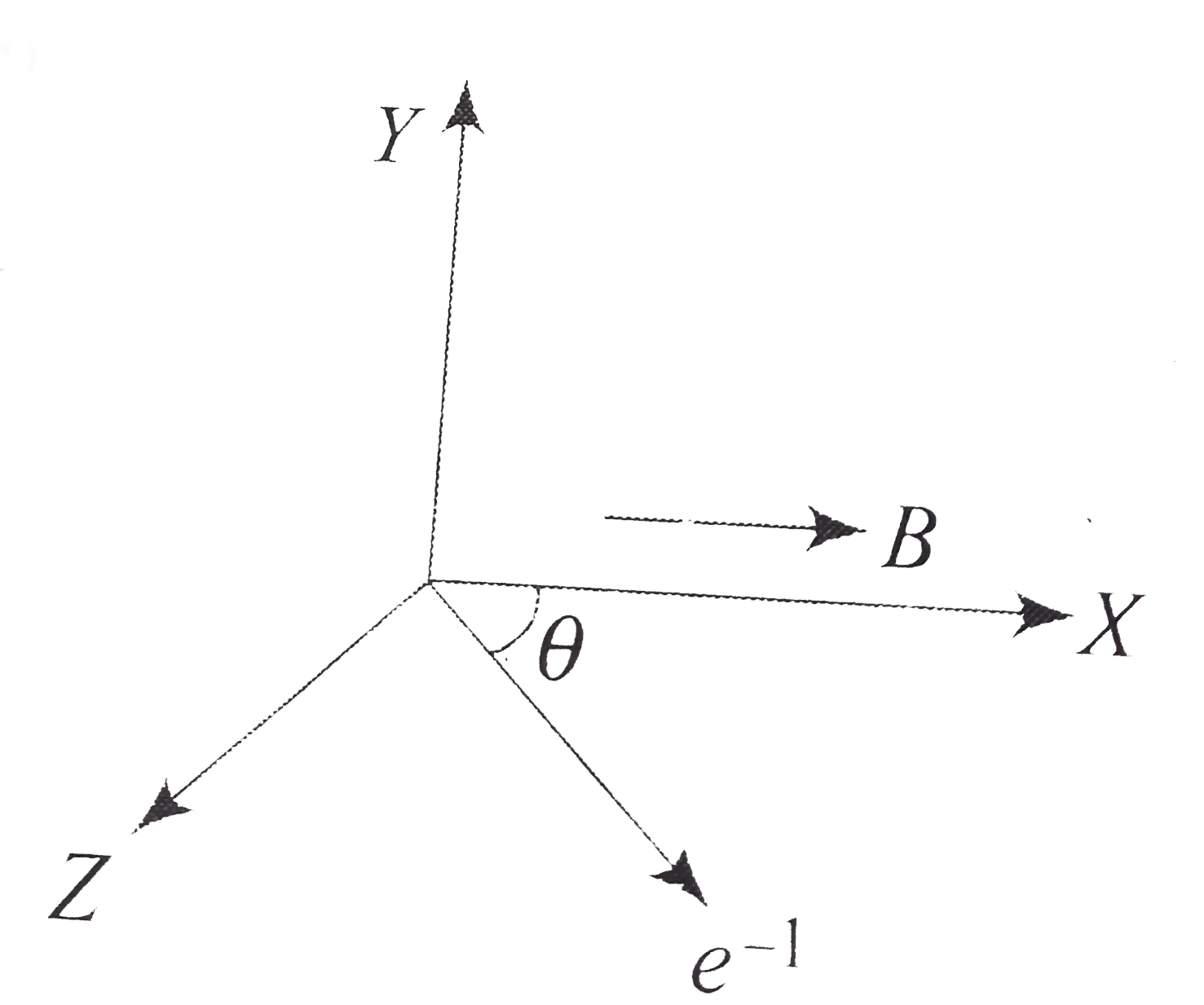
Light having photon energy hυ is incident on a metallic plate having work function ϕ to eject the electrons. The most energetic enectrons are then allowed to enter in a region of uniform magnetic field B as shown in Fig. The electrons are projected In X-Z plane making an angle θ with X-axis and magnetic field is →B=B0ˆi along X-axis maximum pitch of the helix described by an electron is found to be p. Take mass of electron as m and charge as q. Based on the above information, answer the following questions:
Q. Considering the instant of crossing origin at t=0 ,the Z-coordinate of the location of electron as a function of time isView SolutionQuestion 26

Light having photon energy hυ is incident on a metallic plate having work function ϕ to eject the electrons. The most energetic enectrons are then allowed to enter in a region of uniform magnetic field B as shown in Fig. The electrons are projected In X-Z plane making an angle θ with X-axis and magnetic field is →B=B0ˆi along X-axis maximum pitch of the helix described by an electron is found to be p. Take mass of electron as m and charge as q. Based on the above information, answer the following questions:
Q. The plot between X-coordinate of the location of electron as a function of time for different frequencies υ of the incident light isView SolutionQuestion 27
When light of sufficiently high frequency is incident on a metallic surface, electrons are emitted from the metallic surface. This phenomenon is called photoelectric emission. Kinetic energy of the emitted photoelectrons depends on the wavelength of incident light and is independent of the intensity of light. Number of emitted photoelectrons depends on intensity. (hv−ϕ) is the maximum kinetic energy of emitted photoelectron (where ϕ is the work function of metallic surface). Reverse effect of photo emission produces X-ray. X-ray is not deflected by electric and magnetic fields. Wavelength of a continuous X-ray depends on potential difference across the tuve. Wavelength of charasteristic X-ray depends on the atomic number.
Q. If frequency (υ>υ0) of incident light becomes n times the initial frequency (v), then KE of the emitted photoelectrons becomes (v0 threshold frequency).View SolutionQuestion 28
When light of sufficiently high frequency is incident on a metallic surface, electrons are emitted from the metallic surface. This phenomenon is called photoelectric emission. Kinetic energy of the emitted photoelectrons depends on the wavelength of incident light and is independent of the intensity of light. Number of emitted photoelectrons depends on intensity. (hv−ϕ) is the maximum kinetic energy of emitted photoelectron (where ϕ is the work function of metallic surface). Reverse effect of photo emission produces X-ray. X-ray is not deflected by electric and magnetic fields. Wavelength of a continuous X-ray depends on potential difference across the tuve. Wavelength of charasteristic X-ray depends on the atomic number.
Q. A monochromatic light is used in a photoelectric experiment on photoelectric effect. The stopping potentialView SolutionQuestion 29
When light of sufficiently high frequency is incident on a metallic surface, electrons are emitted from the metallic surface. This phenomenon is called photoelectric emission. Kinetic energy of the emitted photoelectrons depends on the wavelength of incident light and is independent of the intensity of light. Number of emitted photoelectrons depends on intensity. (hv−ϕ) is the maximum kinetic energy of emitted photoelectron (where ϕ is the work function of metallic surface). Reverse effect of photo emission produces X-ray. X-ray is not deflected by electric and magnetic fields. Wavelength of a continuous X-ray depends on potential difference across the tuve. Wavelength of charasteristic X-ray depends on the atomic number.
Q. If potential difference across the tube is increased thenView SolutionQuestion 32
The energy reveived from the sun by the earth and surrounding atmosphere is 2 calcm−2 min−1 on a surface normal to the rays of sun.
Q. At what rate, in mega gram per minute, must hydrogen be consumed in fusion reaction to provide the sun with the energy it radiates? (Take mass defect per reaction to be 0.028706 a.m.u)View SolutionQuestion 33
When a high frequency electromagnetic radiation is incident on a metallic surface, electrons are emitted from the surface. Energy of emitted photoelectrons depends only on the frequency of incident electromagnetic radiation and the number of emitted electrons depends only on the intensity of incident light.
Einstein's protoelectron equation [Kmax=hv−ϕ} correctly ecplains the PE, where υ= frequency of incident light and ϕ= work function.
Q. Light of wavlength 3300 is incident on two metals A and B, whose work function are 4 eV and 2 eV, respectively. ThenView SolutionQuestion 34
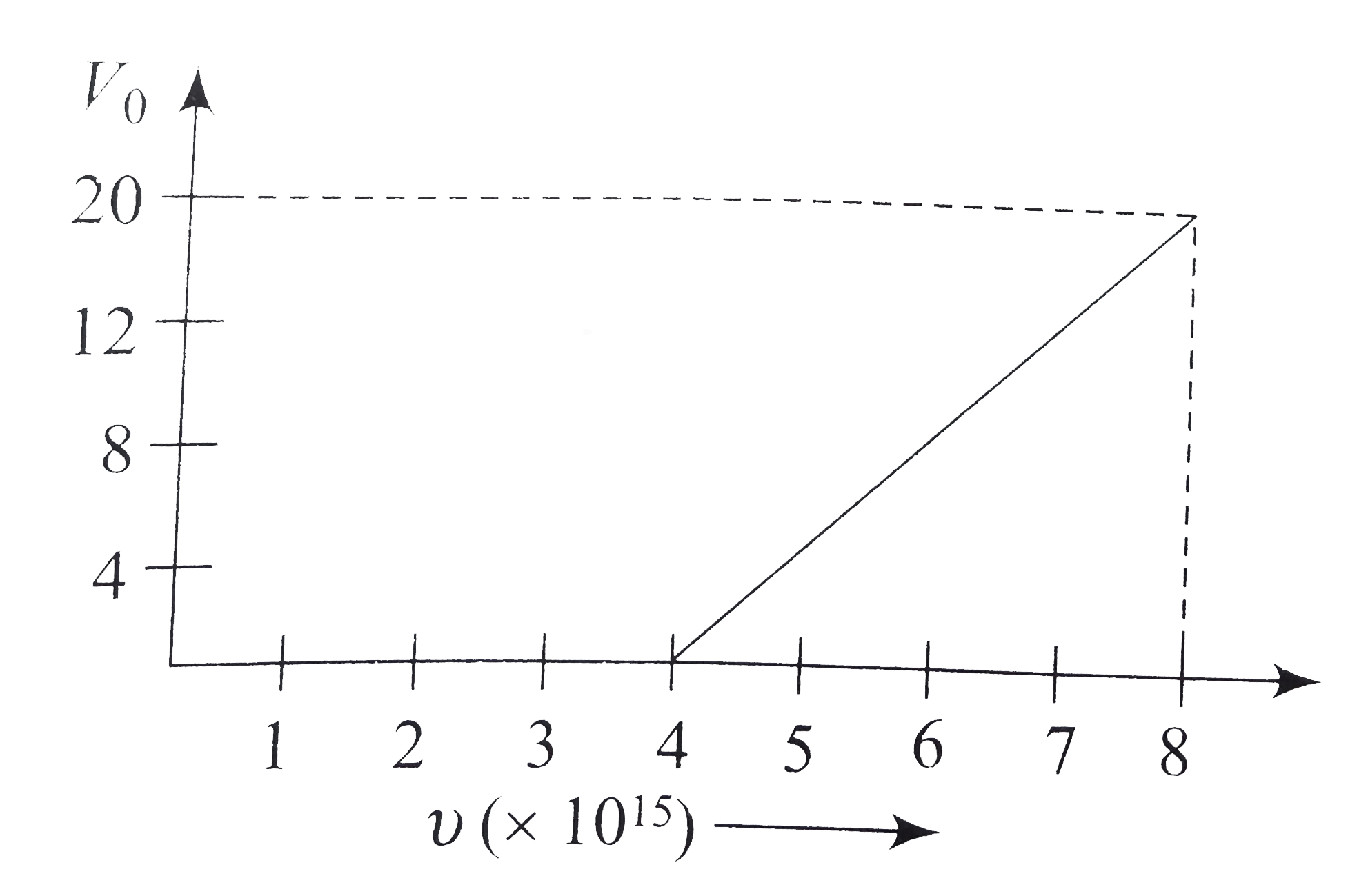
When a high frequency electromagnetic radiation is incident on a metallic surface, electrons are emitted from the surface. Energy of emitted photoelectrons depends only on the frequency of incident electromagnetic radiation and the number of emitted electrons depends only on the intensity of incident light.
Einstein's protoelectron equation [Kmax=hv−ϕ] correctly ecplains the PE, where υ= frequency of incident light and ϕ= work function.
Q. For photoelectric effect in a metal, the graph of the stopping potential V0 (in volt) versus frequency υ (in hertz) of the incident radiation is shown in Fig. The work function of the metal (in eV) is.View SolutionQuestion 35
When a high frequency electromagnetic radiation is incident on a metallic surface, electrons are emitted from the surface. Energy of emitted photoelectrons depends only on the frequency of incident electromagnetic radiation and the number of emitted electrons depends only on the intensity of incident light.
Einstein's protoelectron equation [Kmax=hv−ϕ} correctly ecplains the PE, where υ= frequency of incident light and ϕ= work function.
Q. The slope of the graph shown if Fig. [here h is the Planck's constant and e is the charge of an electron] is View SolutionQuestion 36
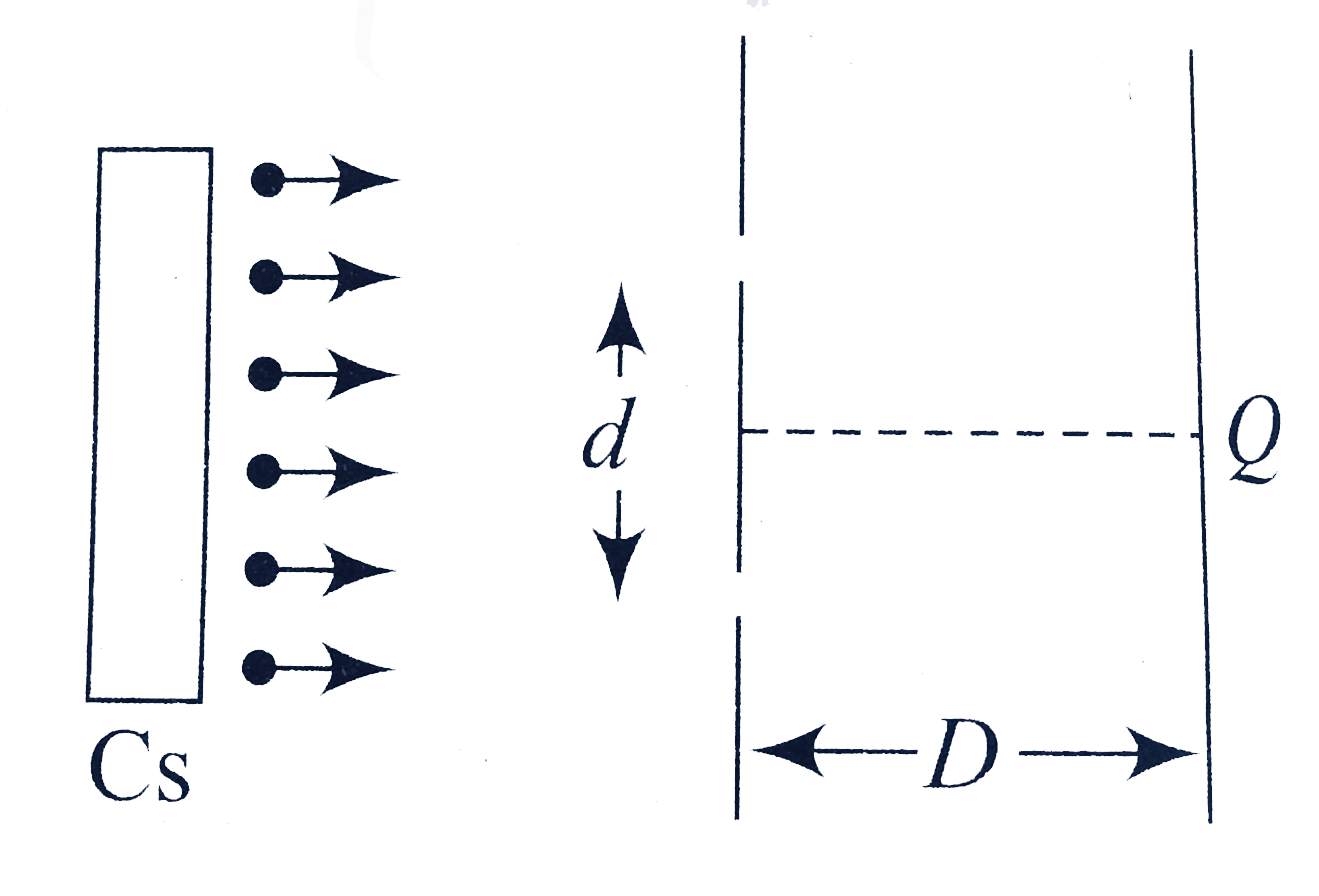
A Cs plate is irradiated with a light of wavelength λ=hcϕ,ϕ being the work function of the plate, h Plank's constant, and c the velocity of light in vacuum. Assume all the photoelectron are moving perpendicular to the plate toward a YDSE setup when accelerated through a potential difference V. Take charge on a proton =e and moss of an electron =m. Read the paragraph carefully and answer the following question:The fringe width due to the electron beam is View SolutionQuestion 37
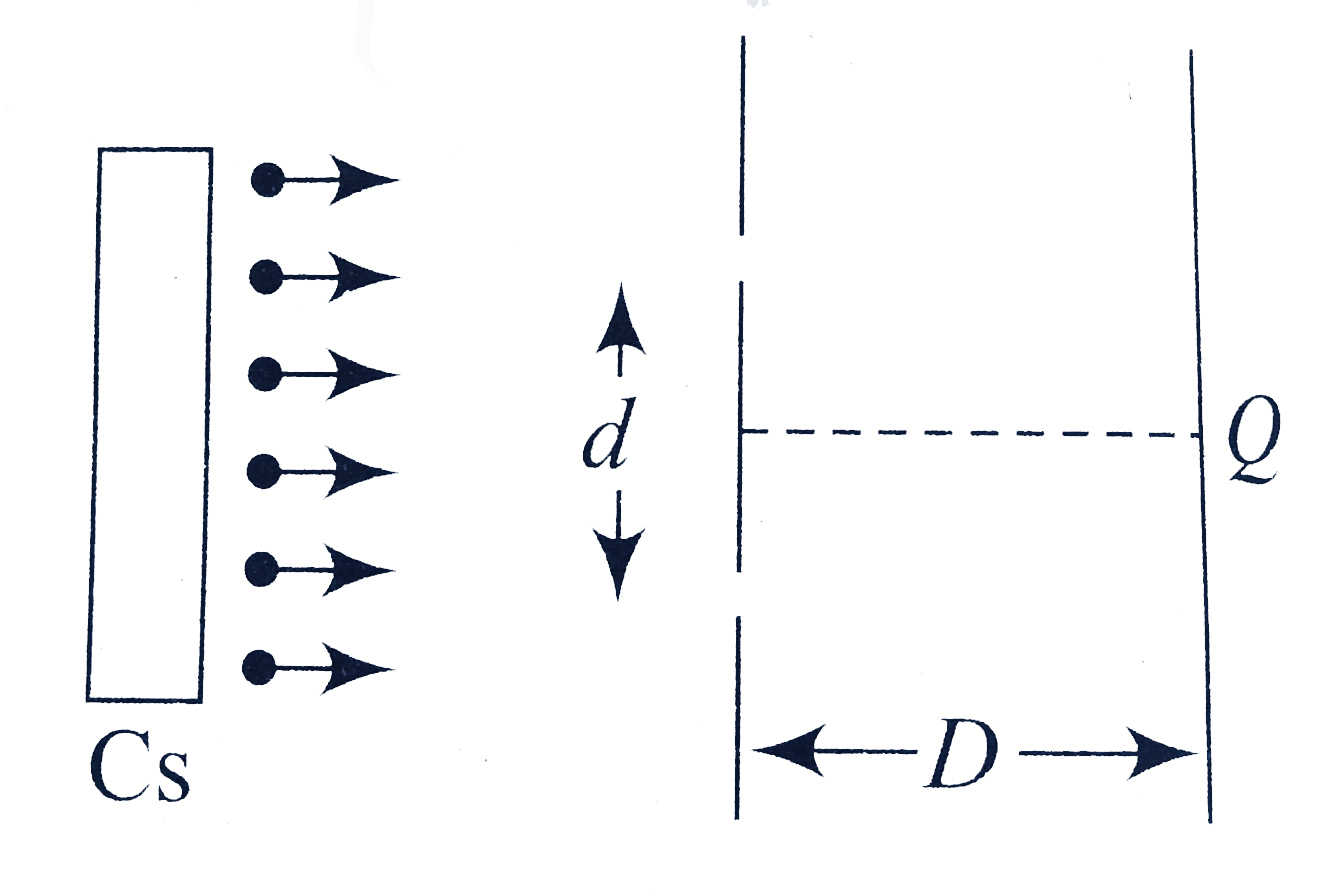
A Cs plate is irradiated with a light of wavelength λ=hcϕ,ϕ being the work function of the plate, h Plank's constant, and c the velocity of light in vacuum. Assume all the photoelectron are moving perpendicular to the plate toward a YDSE setup when accelerated through a potential difference V. Take charge on a proton =e and moss of an electron =m. Read the paragraph carefully and answer the following question:
Q. If the wavelength of light used in photoemission is less that λ, then the fringe width willView SolutionQuestion 38
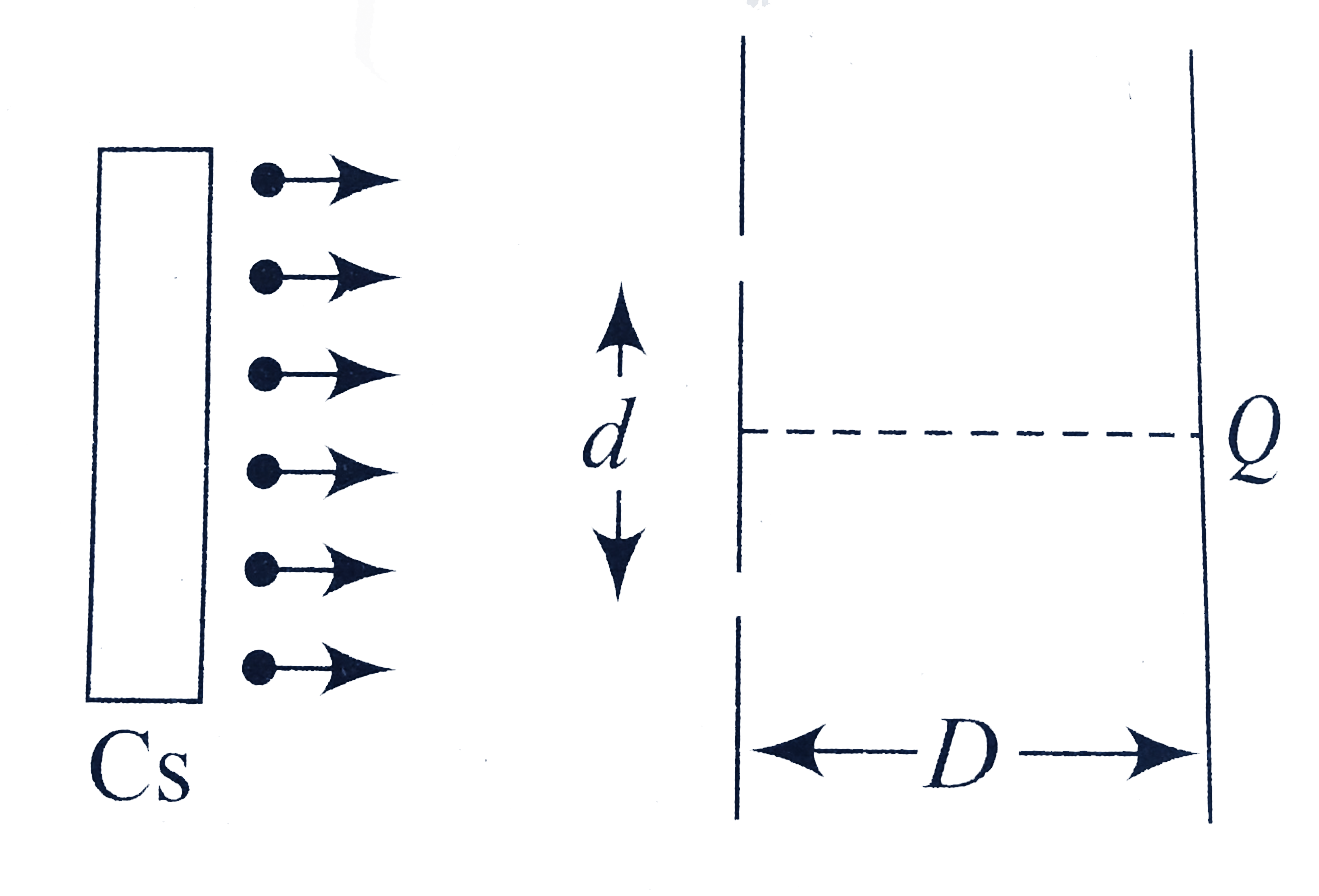
A Cs plate is irradiated with a light of wavelength λ=hcϕ,ϕ being the work function of the plate, h Plank's constant, and c the velocity of light in vacuum. Assume all the photoelectron are moving perpendicular to the plate toward a YDSE setup when accelerated through a potential difference V. Take charge on a proton =e and moss of an electron =m. Read the paragraph carefully and answer the following question:
Q. Instead of moving perpendicular to the plate, if the electrons were moving randomly, then the central maximum would shiftView SolutionQuestion 39
A pushed dye laser emits light of wavelength 585 nm. Because this wavelength is strongly absorbed by the haemoglobin in the blood, the method is especially effective for removing various types of blemishes due to blood. To get a reasonable estimate of the power required for such laser surgery, we can model the blood as having the same specific heat and geat of vaporization as water. [S=4.2×103J(kgK)−1,L=2.25×106Jkg]
Q. Suppose that each pulse must remove 2μg of blood by evaporating it starting at 30∘C. The energy that each pulse must deliver to the blemish is nearlyView SolutionQuestion 40
A pushed dye laser emits light of wavelength 585 nm. Because this wavelength is strongly absorbed by the haemoglobin in the blood, the method is especially effective for removing various types of blemishes due to blood. To get a reasonable estimate of the power required for such laser surgery, we can model the blood as having the same specific heat and geat of vaporization as water. [S=4.2×103J(kgK)−1,L=2.25×106Jkg]
Q. The power output of laser must beView SolutionQuestion 41
A pushed dye laser emits light of wavelength 585 nm. Because this wavelength is strongly absorbed by the haemoglobin in the blood, the method is especially effective for removing various types of blemishes due to blood. To get a reasonable estimate of the power required for such laser surgery, we can model the blood as having the same specific heat and geat of vaporization as water. [S=4.2×103J(kgK)−1,L=2.25×106Jkg]
Q. The number of photons that each pulse delivers to the blemish is View Solution